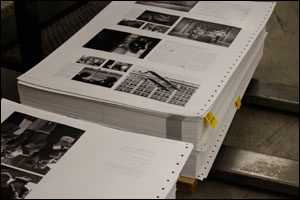Master’s Student Katie Wood Creates Book Based on 62nd Missouri Photo Workshop
‘Macon: The People and Stories of Missouri’s City of Maples’ Documents Life in North-Central Missouri Town
By Nathan Allen
Master’s Student
Columbia, Mo. (Dec. 13, 2011) — The third photo essay book in a series about Missouri communities is now available from the Missouri School of Journalism.

“Macon: The People and Stories of Missouri’s City of Maples” features the work of professional and student photojournalists from all over the United States and 12 foreign countries. The photographs were taken during the 62nd Missouri Photo Workshop, which took place in September of 2010. Nikon Professional Services and the Missouri School of Journalism sponsored the workshop. The printing of the book is made possible through the school’s Missouri Community Newspaper Management Chair, currently held by Professor Jim Sterling.
Macon has a population of approximately 5,000 and is located in the north-central part of the state.
Each of the 37 photo essays in the 176-page documentary-style book is presented as black-and-white photographs, though the originals were in color. A wide range of topics is covered, including elder care, employment, faith, education, entertainment and health.

Graduate student Katie Wood edited, designed and produced the book as part of the requirements for her master’s degree in journalism. For eight months after the MPW, Wood sifted through hundreds of photographs to select those that would accompany each story. She worked with students in two copy-editing classes, designed all of the page layouts, did follow-up interviews with citizens of Macon, worked with the photographers to clarify caption information and prepared the files for the printer.
“This project takes a tremendous amount of organization,” David Rees, co-director of the MPW and chair of the photojournalism faculty, said. Rees and MPW co-director Jim Curley provided oversight and additional editing. “It demands a renaissance person who is able to work in both visuals and text, being able to bring all of the elements together into a sweet symphonic whole, which Katie did a great job at.”
Of all of the stories in the book, Wood said “Salvaged Lives” is one that stands out to her.

“The story is about an extremely interesting and unique woman in her 30’s who is dating a man in his 70’s,” Wood said. “It is something you don’t always see in normal journalism. The photographer, Jill Schneider, did a great job of telling the woman’s story with dignity and compassion.”
Rees agrees that the book shares stories that normally would go untold.
“Each town is distinctive, and each of these book projects has had the strength to tell the stories of the communities,” Rees said. “It’s not all about the bankers and lawyers and upper echelons; it deals with everyone.”
Other MPW books have been produced on St. James and Festus/Crystal City, Missouri’s “twin cities.”
One other noteworthy aspect of the project, Rees added, is the connection between the University of Missouri and the citizens of the state.

“Katie realized the importance of that and embraced it,” he said.
“Macon: The People and Stories of Missouri’s City of Maples” can be purchased on the Missouri Photo Workshop website or by contacting Amy Schomaker in the photojournalism office, 573-882-4882. Special pricing is available for students.
The MPW, which was founded in 1949 by journalism professor Clifton Edom, has recorded rural life for six decades. Over the years, more than 2,000 photographers have documented 44 Missouri communities. The towns are a laboratory for photographers to hone their visual storytelling skills under the guidance of a demanding faculty, some of the nation’s top picture editors and photographers. It is a rigorous week for the photographers, who are expected to follow Edom’s prescription of making meaningful pictures: intensive research, followed by intent observation and judicious timing.
Updated: June 4, 2020